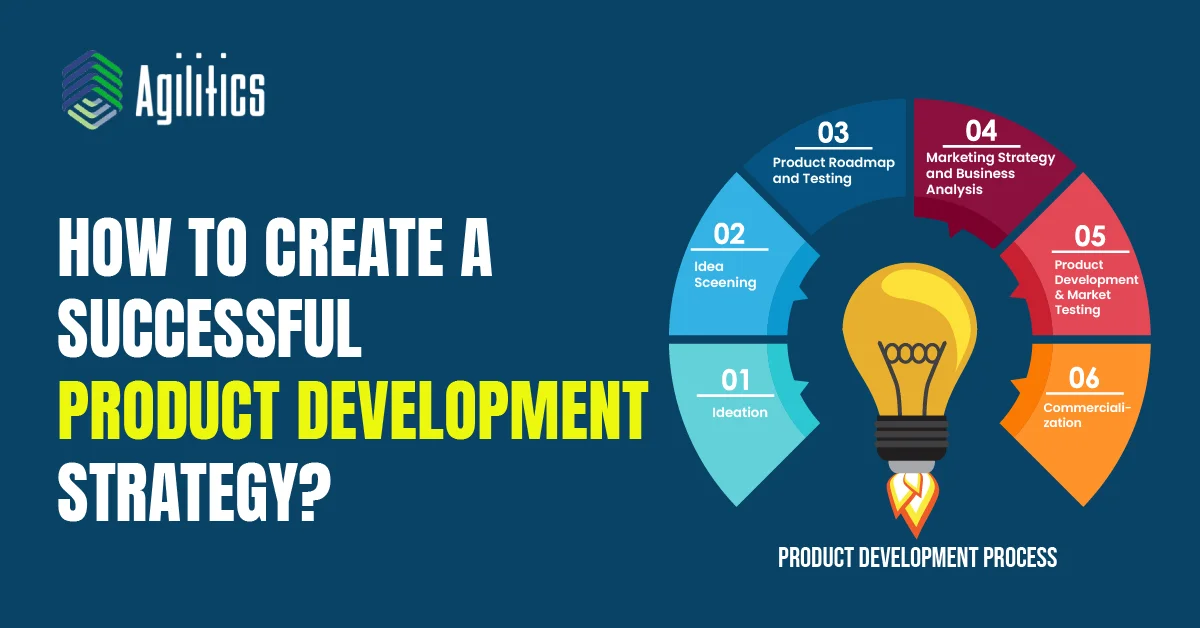Product development is converting an ‘idea’ into a usable product that will provide value to its users. We are surrounded by products, and their demand is only increasing.
But a successful product is not easy to create, and for that, we need a successful product development strategy.
What is a Product Development Strategy?
Product development strategy refers to the process of bringing a new product into an existing or new market. Product development strategy is not exclusive to new products, it can also be about reintroducing existing products into a new or existing market.
This happens usually when a new feature is added to the product, the company is trying to rebrand, or simply to keep up with the competition. The process of bringing a new/existing product into the market encompasses numerous steps, from ideation to the launch of the final product.
The product development strategy usually works hand in hand with the business strategy, to ensure they are working towards the same goal, that is business growth. The goal can vary and so can the product development strategy, for instance, if it plateaus due to a saturated market, then the company can choose to develop a new product.
And in cases where an existing product is performing well but can be improved then the company opts to add new features. Professionals & organizations often use the Ansoff Market to make strategic growth & marketing decisions.
Importance of a Product Development Strategy
A successful product needs a bulletproof product development strategy, as it is a must-have to achieve business goals and much more. A few benefits of developing & implementing a product development strategy are:
- The product development process requires a cross-functional team. For a successful collaboration between different teams, everyone involved should be clear on the end goal. A product development strategy clearly defines the steps involved in achieving it. This ensures smooth operation and limits hiccups that might arise due to ambiguity around functions & goals.
- It allows the team to perform sufficient testing to ensure that their product will resolve the pain points of their buyers and if they need to update certain features or pivot from their original plan.
- A well-defined product development strategy enables smart resource allocation and generates an estimated time frame for each step of the development process. This eliminates unrealistic expectations from the stakeholders involved since everyone is on the same page at every step of the way.
Recommend Reading: Product Manager VS Product Owner - What Is the Difference?
What is the New Product Development Strategy Process?
The New Product Development (NPD) process can be understood as taking advantage of the opportunity presented by the market. To put it simply, it is converting an idea into a workable software/product that caters to the customer’s needs and has a decent demand in the market.
The new product development process consists of multiple steps that are followed by SMEs and enterprises alike. They are:
Ideation
The first & foremost process in the product development lifecycle is to come up with an idea that can further be converted into a product. This step focuses on brainstorming multiple ideas that can resolve customer pain points.
While coming up with ideas, the focus should be on solving a real problem faced by the organization or the customers. Once the problems have been identified, move on to prioritizing which problem to solve first.
The final stage is coming up with a solution to the problem. Following these steps will help you come up with detailed ideas that can later be taken up for discussion.
Filtering the Ideas
Those ideas are then put under heavy scrutiny by the entire team to choose the best idea that is practical, aligns with the business goals, is customer-centric, and can be developed with the available resources.
Another key point is to have a proof of conception (POC) for each of the presented ideas. Take up the ideas for discussion amongst the internal team and include subject matter experts as well to understand the technical side & practicality of the idea.
Product Roadmap & Testing
Once an idea has been shortlisted create a more detailed version & user stories or a product roadmap. While doing so identify what the customers can gain from the product. Perform due competitor analysis to understand the gaps and enter the white space in the market.
Listing the product features will provide a deeper understanding & function of the product and will garner better feedback during the testing phase.
It is imperative to put a product concept through a test and present it to a targeted group of people who can be potential customers. The feedback received from the targeted group will help you identify the gaps, scope of improvement, and if the product is customer-centric or not.
Developing a Marketing Strategy & Business Analysis
After the product concept development & testing is done, it is essential to create a marketing strategy. A marketing strategy allows you to keep track of key metrics.
How you present your product to the market is a key factor in developing a successful product development strategy. A few points that are taken care of in marketing strategy are:
- Target Audience
- Value Proposition
- Product Pricing
- Marketing Budget
- Profit & sales goals
A successful product should achieve the business goals, make sure to conduct market surveys or competitors for thorough business analysis.
Product Development & Market Testing
Once the product idea has been finalized, with a well-documented marketing strategy and a completed business analysis, it is time to develop the product.
The new product development process starts with developing a prototype that generally focuses on the UI/UX of the product. It is then distributed to the stakeholders & internal teams to visualize the final product.
Approval of the prototype leads to the development of a minimum viable product (MVP). The minimum viable product is launched in the market with minimum features. It is a testing face to gauge the response of the end users.
The response then dedicates the further development of the product & implementation of new features. Agile product development is the best way to approach new product development as it focuses on iterative development through cross-functional collaboration & communication.
Commercialization
A great product can turn into a failure with the wrong strategy. The success of your product depends on how you promote or sell your product, often people don’t understand the intent behind the product which leads to its failure.
Create a need for the product, and highlight its unique selling points instead of simply focusing on product features. Create a brand image to set yourself apart from other similar products, and disseminate the information about your product through various channels, be it social media or webinars.
Stages of a Product Development Strategy
If you have a clear product development process mapped out, you can launch a successful product. It can be an upgraded version of an existing product or a new product, it depends on your business requirements.
To stay relevant in the market and compete with other products, here are a few stages of a product development strategy that you can implement.
Upgrading Existing Products
Modifying an existing product by adding new features can give your product a massive boost. Study the market and customer requirements to identify the in-demand features or what aspects of your product can be improved.
This will create a need amongst the customers to buy the upgraded version of the product.
Offer Free Product Trials
Customers usually don’t want to invest in a new or upgraded product. To climb over this issue you can offer free product trials to the customers and gain their trust. That can be a good feedback stage for you as well to understand if your product is being accepted well or not.
Increase Product Value
You have a product X with strong customer support, better features, discounts, and free trials and another company has a product Y without the added benefits – your product is winning!
People want to pay the same amount but for better services and you are doing just that.
Customization
What is the best way to attract customers? Offer a customized service catering to their specific needs. A customer will only stay loyal to you if you are offering them something beyond a generic experience.
You can create offers or new features for a targeted audience to create a feeling of exclusivity.
Create a Product Line
To establish authority in your industry and gain the trust of your customers, launch new products to create a product line. You can launch new products that align with your market & audience and lead to a great product mix.
Identify New Markets
For a stable long-term product, you need to identify new markets. A single product can be used in different markets and by people from different locations, demographics, and backgrounds.
Recommend Reading: Product owner interview questions.
Types of Product Development Strategies
Product Development strategies are branched out into two types, a Proactive Product Development Strategy, and a Reactive Product Development Strategy.
Let’s dive into the details.
1. Proactive Product Development Strategy
Proactive means creating or controlling a situation rather than just responding to it after it has happened. That is the essence of a proactive product development strategy. This strategy analyzes the market trends and anticipates the need for a product or feature before its launch.
This gives the company a head start against the competition. Companies following this strategy invest a great deal in market research for the product development process. They don’t shy away from taking risks and embrace entrepreneurship.
2. Reactive Product Development Strategy
Reactive means acting in response to a situation rather than creating or controlling it. A reactive product development strategy is followed when there is a change in the industry or demand.
There are four approaches to a reactive product development strategy:
- Responding to customer requirements
- Responding to competition in the market
- Upgrading the product to stay ahead of competitors
- Reducing the product price to make market penetration difficult
To sum it up, a successful product cannot thrive alone on a brilliant idea. It needs a stable product development process & a great strategy to leave a mark in the market. Launching a great product can sound daunting, thus performing due diligence and creating a solid process & strategy will be your best friends in the entire product development life cycle.
We strive to provide business professionals with the skills and knowledge necessary to increase work performance and drive greater return on investment for the global customers we support. Agilitics delivers customized technology and management training solutions to large corporations and government agencies around the world.


